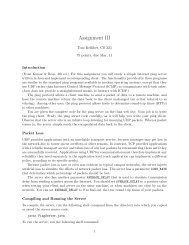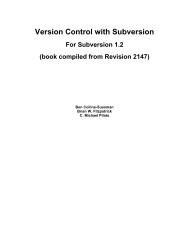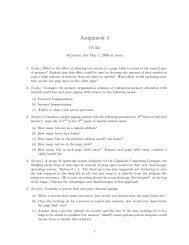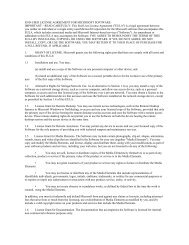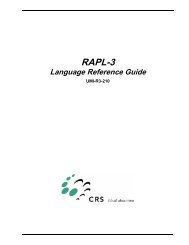Flesh and Machines - Phoenix Goucher
Flesh and Machines - Phoenix Goucher
Flesh and Machines - Phoenix Goucher
You also want an ePaper? Increase the reach of your titles
YUMPU automatically turns print PDFs into web optimized ePapers that Google loves.
an object rather than a living creature.<br />
Are there other fields of endeavor where we are able to really make artificial systems act like real biological<br />
systems? Beyond robotics, there is another field, artificial life, or Alife, in which biology is modeled, <strong>and</strong>, as<br />
in robotics, we have made tremendous progress in building systems with interesting properties. But as with robotics,<br />
there is well-founded criticism that so far the systems are not as robust, <strong>and</strong> ultimately as lifelike, as real biological<br />
systems.<br />
In Alife people have built systems that reproduce, inside a computer-based world. Back at the beginning of the<br />
nineties, Tom Ray, then a biologist at the University of Delaware, developed a computer program called Tierra. This<br />
system simulated a simple computer so that Ray could have complete control over how it worked. Multiple<br />
computer programs competed for resources of the processing unit in the simulated computer. Ray placed a single<br />
program in a 60,000-word memory <strong>and</strong> let it run. (His words were only five bits, to approximate the information<br />
content in three base pairs of amino acids where there are only twenty proteins coded for plus a little control.) The<br />
program tried to copy itself elsewhere in memory <strong>and</strong> then spawn off a new process to simultaneously run that<br />
program. In this way the memory soon filled with simple "creatures" that tried to reproduce by copying themselves.<br />
Like the DNA in biological systems, the code of the computer program was used in two ways. It was interpreted to<br />
produce the process of the creature itself, <strong>and</strong> it was copied to make a child program. The simulated computer,<br />
however, was subject to two sources of error. There were "cosmic rays" that would occasionally r<strong>and</strong>omly flip a bit<br />
in memory, <strong>and</strong> there were copying errors where, as a word was being written to memory, a r<strong>and</strong>om bit within it<br />
might flip. Thus as the memory of the simulated computer filled with copies of the original seed program, mutations<br />
appeared. Some programs simply failed to run anymore <strong>and</strong> were removed. Others started to optimize <strong>and</strong> get<br />
slightly smaller, because the scheduling policy for multiple programs implicitly had a bias for smaller programs.<br />
Before long, "parasites," less than half the size of the original seed program, evolved. They were not able to copy<br />
themselves, but they could trick a larger program into copying them rather than itself. Soon other sorts of creatures<br />
joined them in the soup, including hyper-parasites, <strong>and</strong> social programs that needed each other to reproduce.<br />
When Tom Ray presented this work at an Alife conference in Santa Fe in 1991, there was great excitement. It<br />
seemed as though this were the key to building complex lifelike systems. Instead of having to be extremely clever,<br />
perhaps human engineers could set up a playground for artificial evolution, <strong>and</strong> interesting complex creatures would<br />
evolve. But somehow a glass ceiling was soon hit. Despite many years of further work by Ray <strong>and</strong> others, <strong>and</strong><br />
experiments with thous<strong>and</strong>s of computers connected over the Internet, nothing very much more interesting than the<br />
results of the first experiments have come along. One hypothesis about this was that the world in which the<br />
programs lived was just not complex enough for anything interesting to happen. In terms of information content, the<br />
genomes of his programs were four orders of magnitude smaller than the genome of the simplest self-sufficient cell.<br />
Also, the genotype—the coding—<strong>and</strong> the phenotype—the body—for Ray's creatures were one <strong>and</strong> the same thing.<br />
In all real b iology the genotype is a str<strong>and</strong> of DNA, while the phenotype is the creature that is expressed by that set<br />
of genes.<br />
A few years later Kari Sims came along <strong>and</strong> built an evolution system in which the genotypes <strong>and</strong> phenotypes where<br />
different. His genotypes were directed graphs with properties that allowed easy specification of symmetry <strong>and</strong><br />
segmented body parts, such as multisegment limbs. Each element of the phenotype expressed by these genotypes<br />
was a rectangloid box that might have sensors in it, actuators to connect it to adjacent rectangloids, <strong>and</strong> a little neural<br />
network, also connected to the neural networks of adjacent body parts. A creature was formed out of many different<br />
sized rectangloids, coupled together to form legs, arms, or other body parts. The specified creature was placed in a<br />
simulated three-dimensional world with full Newtonian physics including gravity, friction, <strong>and</strong> a viscous fluid filling<br />
the volume. By changing the parameters of the fluid it could act like water, air, or a vacuum.<br />
Sims had about a hundred creatures simulated in a generation. They would be evaluated on some metric, or fitness<br />
function, like how well they swam or crawled, <strong>and</strong> then the better ones would be allowed to reproduce. As with<br />
Ray's system, there were various ways in which mutations could happen. Over time the creatures would get better<br />
<strong>and</strong> better at whatever they were being measured for. The first sorts of creatures Sims evolved were those that could<br />
swim in water. Over time they would evolve either into long snakelike creatures or into stubbier creatures with<br />
flippers.<br />
When these were placed on dry ground, they could not locomote very well, but by selecting for creatures that were<br />
better at locomoting, soon they evolved to be better <strong>and</strong> better at it. Some interesting results occurred along the way.<br />
Sims soon found he had to be very careful about exactly what fitness function he chose, or evolution would often



